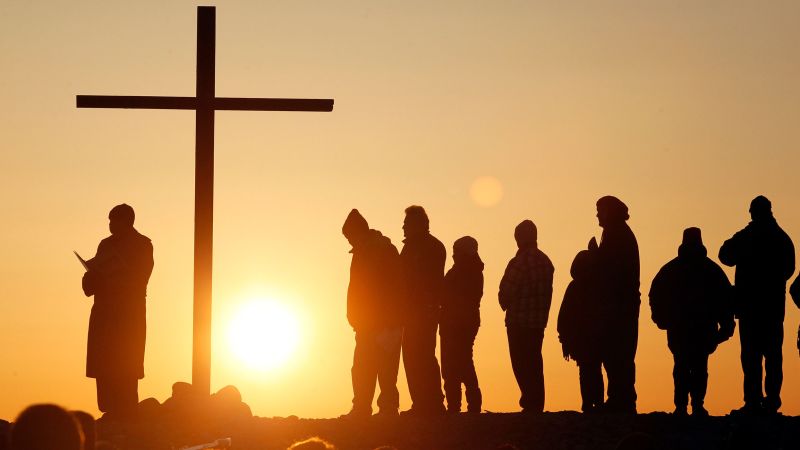Navigating Towards a Flourishing Tomorrow: An Extensive Exploration of the Prospects and Strategies for the Future of Christianity in America
Photo by
on
## Introduction
The cross and the empty tomb – symbols that encapsulate the Easter story and represent the tragic execution of Jesus and the Christian belief in his resurrection. As millions of Americans celebrate Easter, the conversation about the future of Christianity in the United States takes center stage. For years, there have been dire warnings about the demise of Christianity in America, comparing it to the decline of churches in Western Europe. However, a different narrative emerges when top religion scholars and historians are consulted. They suggest that the American church has the potential for a revival due to the influx of Christian migrants. While declining numbers pose a challenge, the ability to adapt to this migration wave may be the key to Christianity’s future in America.
A History of Resilience
Throughout history, there have been predictions of Christianity’s extinction in the United States. Even Thomas Jefferson, one of the nation’s founding fathers, foresaw the replacement of Christianity with a more enlightened form of religion in the 1820s. However, these predictions have been consistently proven wrong. Revivals, such as the Second Great Awakening, have revitalized Christianity and reaffirmed its influence in American society. Joseph P. Slaughter, a historian and assistant professor of religion, expresses his optimism in American Christianity’s adaptability and its ability to shape society.
The Numbers Game
Despite the positive outlook, recent polls paint a grim picture of Christianity in America. The percentage of Americans identifying as Christian has declined from 90% fifty years ago to 64% today, according to a 2020 Pew Research Center study. Projections suggest that the Christian majority in the US may disappear by 2070. The COVID-19 pandemic further impacted church attendance, with a Gallup poll revealing that church membership has fallen below 50% for the first time. Additionally, the church’s reputation has been tarnished by sex abuse scandals, the spread of White Christian nationalism, and perceived oppression of marginalized groups. The rise of the “nones,” those who identify as atheists, agnostics, or unaffiliated, poses a significant challenge to Christianity’s future.
The Power of Migration
While the numbers may seem discouraging, religious scholars believe that the migration of Christians from the Global South may breathe new life into American Christianity. Latin America, Africa, and Asia are experiencing a boom in Christianity, with the world’s largest megachurch located in South Korea. The US, being a country with a significant immigrant population, has seen a surge of Christian migrants bringing their religious fervor with them. This “Browning of America” demographic shift, which predicts White people becoming the minority by 2045, could revitalize the religious landscape. The fastest-growing group of evangelicals in the US are now Latino evangelicals, suggesting a potential for a multiethnic and immigrant-led future of American Christianity.
Challenges and Opportunities

The future of American Christianity faces challenges on multiple fronts. The rise of White Christian nationalism, rooted in the belief of a White Christian nation, clashes with the influx of non-White Christian immigrants. Progressive Christians may struggle to align with conservative views on sexuality and gender held by many of these immigrants. However, scholars argue that the church’s fear of these potential conflicts should be replaced by the message of Easter – the conquering of fear and the embrace of the “other.” By putting aside fear and embracing diversity, Christianity can experience its own resurrection and thrive in a multiethnic community led by immigrants and their descendants.
Influence Beyond Numbers
While declining numbers may suggest a diminishing influence, recent events demonstrate the continued relevance of Christianity in American society. White evangelicals played a significant role in the election of former President Trump, and conservative Christian groups have successfully advocated for the passage of laws restricting LGBTQ rights. Atheism remains a taboo in American politics, with voters still preferring candidates who profess or evoke Christian beliefs. Lee M. Jefferson, an associate professor of religion, emphasizes that strength and influence cannot be solely measured by numbers or attendance. Christianity continues to hold cultural capital in America, shaping landscapes beyond the physical presence of church buildings.
The Complexity of Affiliation
The rise of the “nones” in America, those who are disaffiliating with institutionalized religion, may not necessarily indicate a decline in spirituality. Many Americans still practice spirituality through prayer, meditation, and occasional attendance at religious houses of worship. Surprisingly, American “nones” exhibit higher levels of religious commitment compared to their European counterparts. This suggests that while institutionalized religion may be losing its appeal, spirituality and belief in a higher power remain integral to many individuals’ lives.
Uncertain Future, Resilient Path Forward
The future of Christianity in America remains uncertain, with declining religiousness and the complexities of human nature posing challenges. Xenophobia and restrictive immigration policies could limit the influx of non-White Christian migrants, hindering the potential revitalization of the church. The willingness of progressive Christians to embrace conservative views held by many immigrants is also a key factor. However, scholars and religious experts offer hope for a vibrant future as they envision a multiethnic and immigrant-led Christianity. By overcoming fear, embracing diversity, and aligning with the Easter message of liberation, the American church can experience its own resurrection and thrive in an ever-changing society.
Conclusion
While predictions about the decline of Christianity in America have been prevalent, the reality is more complex. The church has a history of resilience and adaptability, with revivals breathing new life into its influence. Declining numbers and the rise of the “nones” pose challenges, but the migration of Christians from the Global South offers an opportunity for revitalization. Embracing a multiethnic and immigrant-led future, along with overcoming fear and promoting diversity, can lead to the resurrection of American Christianity. As the nation continues to evolve, the church’s ability to adapt and remain relevant will be crucial in shaping the religious landscape of the United States.
